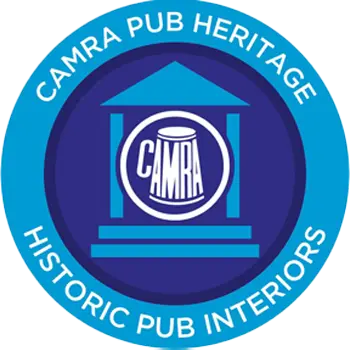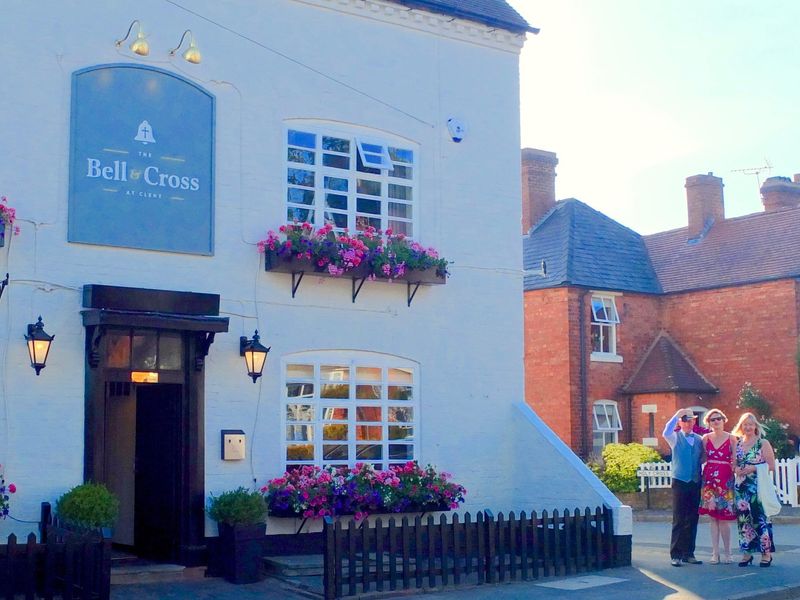

Grade II listed, traditional brick whitewashed building of historic interest, with a small cosy traditional bar, a Victorian counter and real fire, used by locals and pre-dinner drinkers. Timothy Taylors and Wye Valley beers plus occasional guest ales. Three futher traditional dining rooms with modern touches, which can also be booked for private events. Plus a delightful historic cosy snug for drinking, dining or social groups, which also can be booked for functions. A La Carte menu dining and afternoon lite bites. Sunny, enclosed rear garden with extensive covered areas for drinking and dining, large lawn and spacious patio. Close to the Clent Hills (NT). The pub reopened in September 2023.
Historic Interest
Has been a pub for nearly 200 years. Victorian counter. Numbered rooms. Fixed seating. Quarry-tiled corridor.
Three star - A pub interior of outstanding national historic importance
Listed status: II
A pub for nearly 200 years, the Bell & Cross has grown over time to five separate rooms and, despite the current emphasis on food, a strong sense of the traditional small village pub can still be captured. The central quarry-tiled corridor runs to the rear and the tiny hatch on the left was, no doubt, used for off-sales. Behind is the little public bar with a possibly Victorian counter and bar back plus some old fixed seating; the fireplace is probably inter-war. Right of the entrance, a delightful snug is created by a pair of full-height timber partitions which form the backs to the fixed seating within. Thousands of pub rooms up and down the country would once have resembled this cosy space. Room '6' beyond was apparently once the landlord's living room while Room '4', facing it, was the gentlemen's smoke room. At the back, a further room was created out of a barn in 1998. These last three rooms have been refitted in recent years.
A prominent painted brick building in the centre of the village and known to have been a pub for nearly 200 years. It retains its original three rooms and two more brought into use and, although there is a heavy emphasis on food nowadays, a good sense of a traditional, small village pub can still be recaptured. The central entrance leads to a red and black quarry-tiled corridor that runs to the rear - note the figure '2' on the inner door and the tiny hatch in the wall on the left, which was the off sales. Off to the left is the small public bar with a figure '3' on the door. These numbers were a requirement of the licensing magistrates.
The splendid little altered public bar is kept exclusively for drinkers. It has an angled bar back which was originally just the corner piece with decorative architrave and was probably a display for bottles prior to the addition of a bar counter. Then in the period 1890 to 1910 a bar counter and the three-bay bar back fitting were added. If you take a look at where the bar counter meets the bar back and you will see remains of an old bar counter. Then in the inter-war period the bar counter was replaced – you can see how the console brackets on the front of the present counter are much larger than the two on the old counter and the contour on the top of the bar counter is larger and cruder. Bar back shelving is held up by delicate pillars. There is a section of panelled dado by the door, old fixed seating in two sections with a baffle by the door. The brick fireplace looks to date from the 1950s.
On the right the corridor has a timber and glass full-height screen which curves off to the right and which forms the wall for a wonderful old room on the right, which is complete apart from losing its door. This small space looks just as many thousands must have done up and down the land. Note the meat hooks in the ceiling. The fireplace again looks to be post-war brick under a former inglenook. The original bench seating runs all around the room right up to the fireplace, which now has a modern fire in front of it.
This snug could be called one of the UK’s best pub rooms as there are only a handful of similar rooms or snugs formed of two or more high backed settles left in the whole of the UK. However, the modern furniture and the room being ready for diners detracts from its traditional quality. There are only a handful of similar rooms or snugs formed of two or more high backed settles left in the whole of the UK. They can be found at the following Heritage Pubs – the Holly Bush, Mackeney, Derbyshire; Malt Shovel, Spondon, Derbyshire; Green Dragon, Flaunden, Hertfordshire; Red Lion, Kenninghall, Norfolk; North Star, Steventon, Oxfordshire; Kings Head, Laxfield, Suffolk; Old White Beare, Norwood Green, Yorkshire, West; Red Lion, Llansannan, North West Wales;; Crown, Snape, Suffolk;; Wheatsheaf, Raby, Merseyside;; Galway Arms, East Retford, Nottinghamshire;; andAnchor, High Offley, Staffordshire .
The room beyond the partitioned one was the licensees private living room until c.1960. Opposite and behind the public bar is was what formerly the Gentlemen's Smoke Room. At the rear is a larger room created out of a former barn and which has the figures '17' on the door! These three rooms to the rear of the pub have been refitted in modern times and it is good to see the minor refurbishment carried out Nov 07 retained the original layout and fittings. Recent modifications have seen the doors removed from the rear two rooms, and the bell push removed from the Gentlemen's Smoke Room.
This Pub serves 1 changing beer and 3 regular beers.
Bell & Cross, Clent